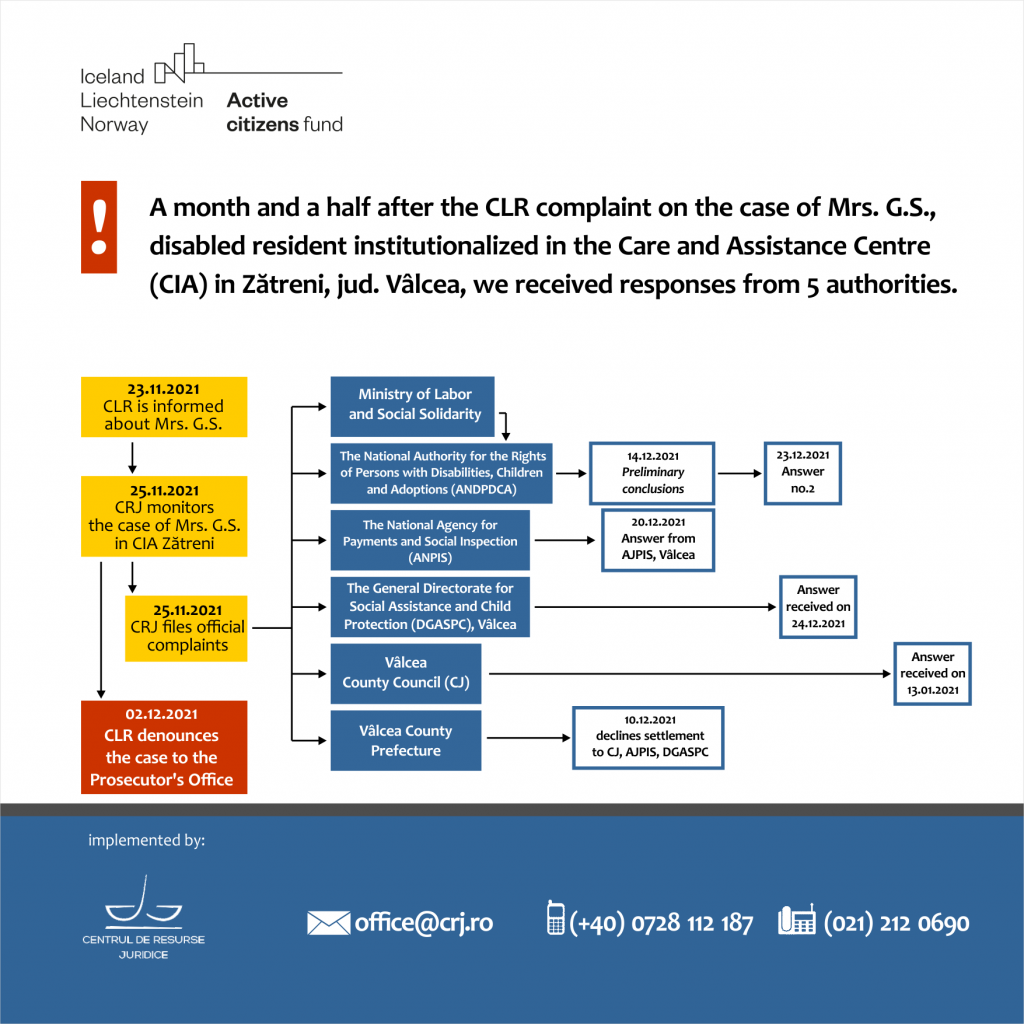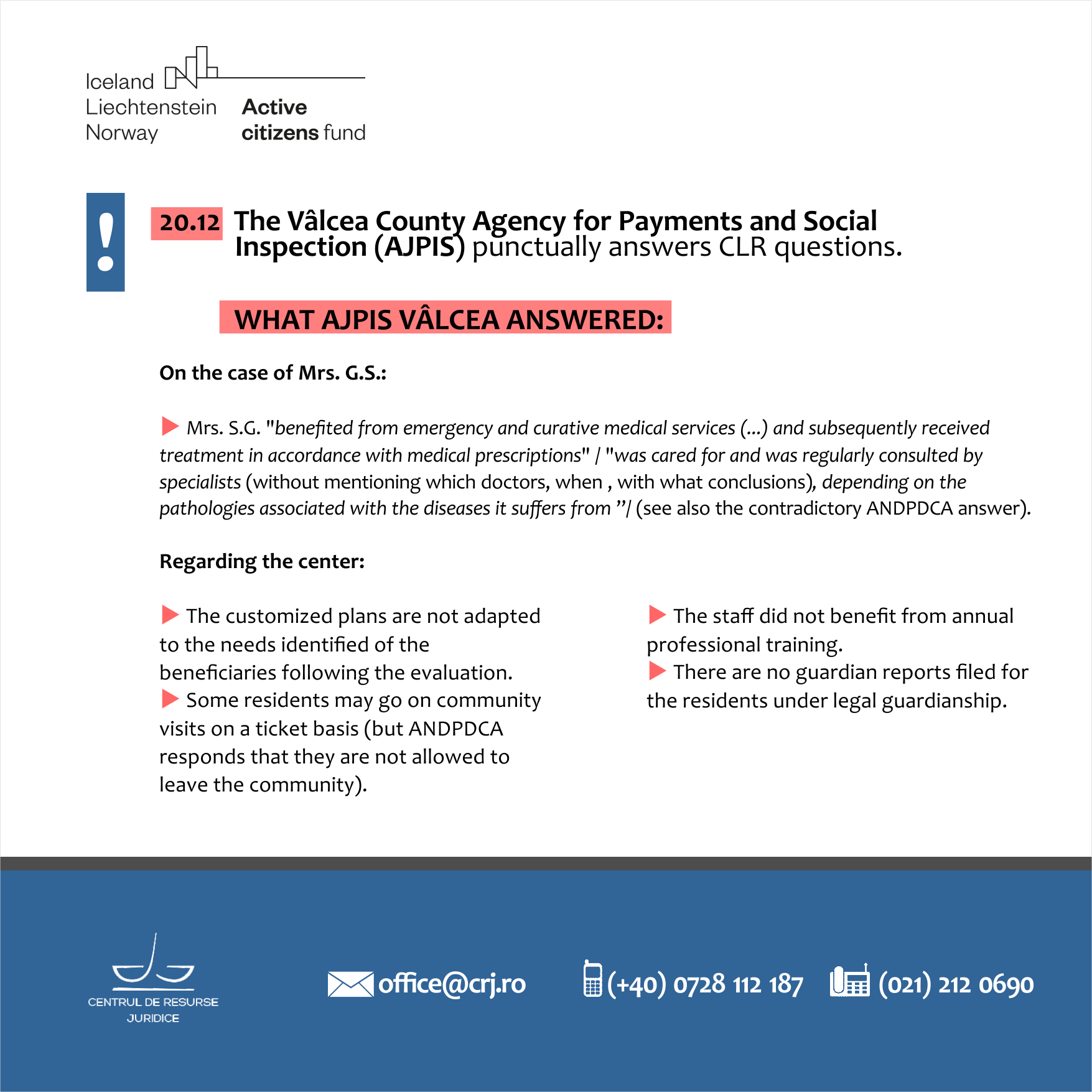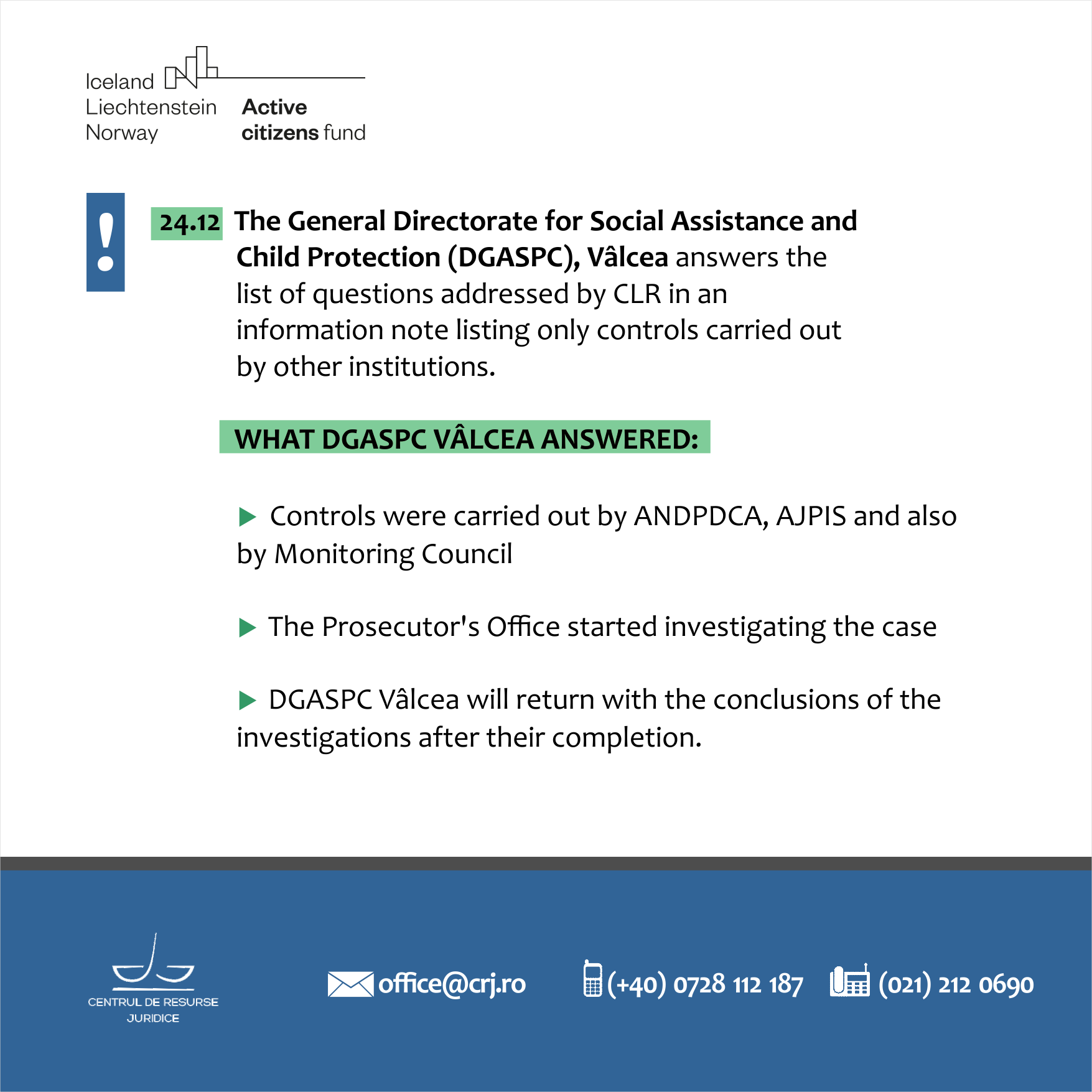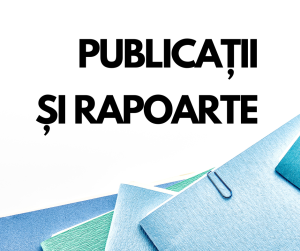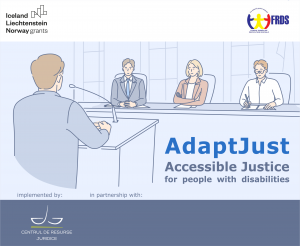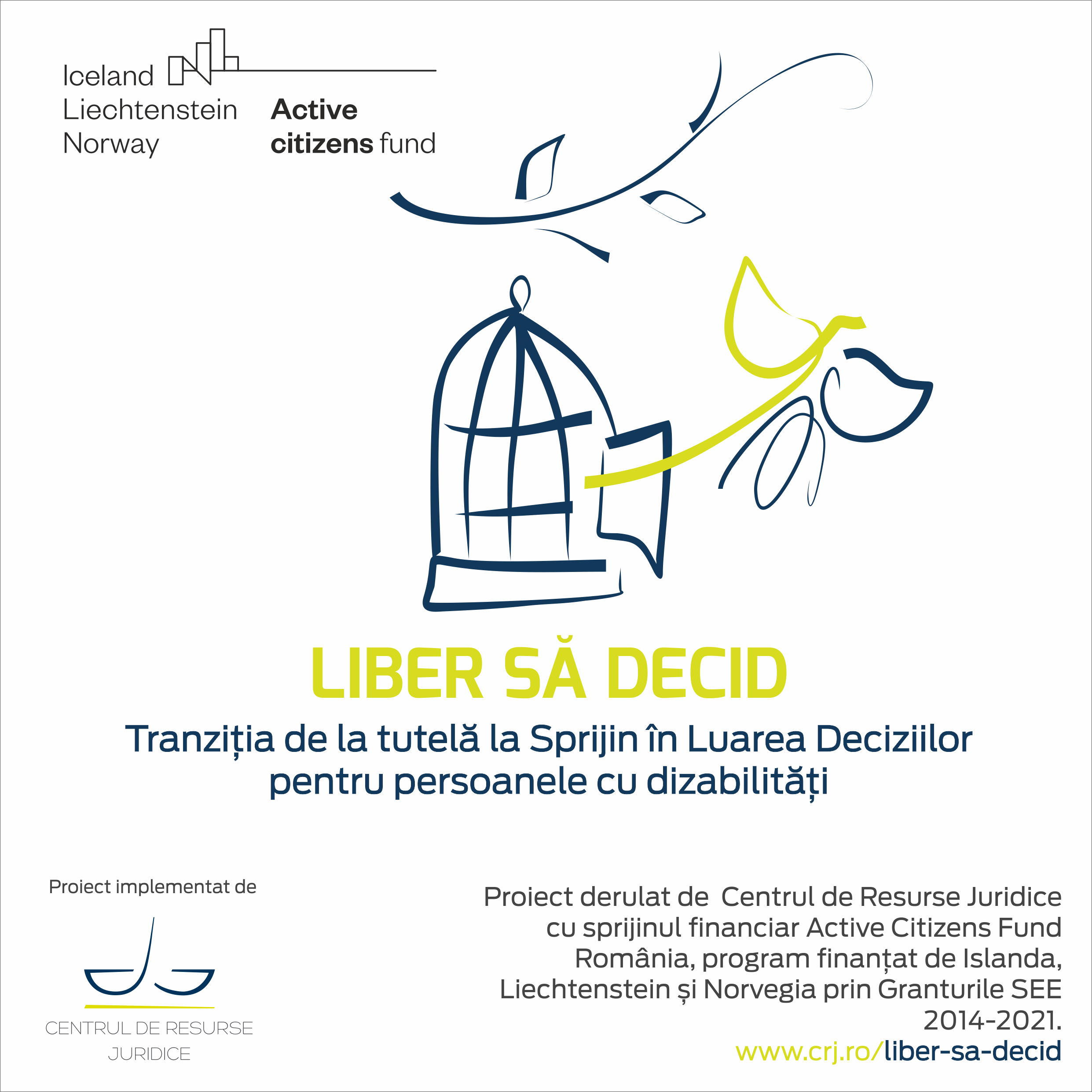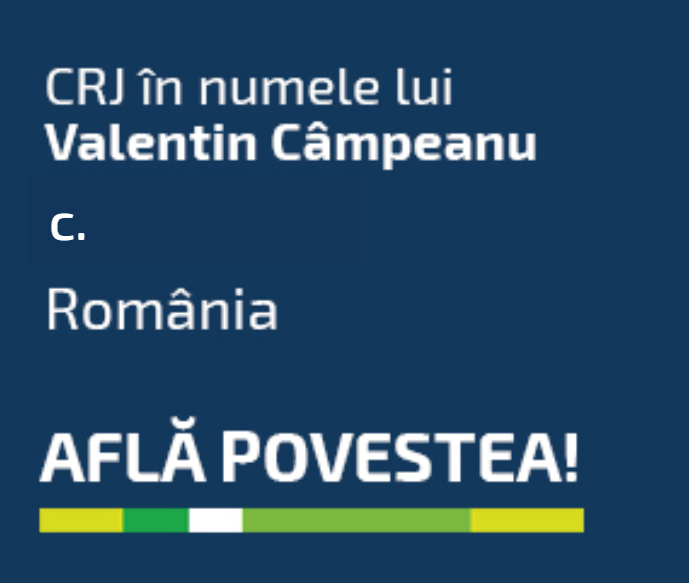Context: On November 23 2021, the Center for Legal Resources (CLR) received a telephone referral regarding the case of a young woman with intellectual and sensory (visual) disabilities, Mrs. S.G., who had been suffering from a femoral fracture for four months, occured in the Care and Assistance Center (CIA) in the commune of Zătreni, Vâlcea County, Romania and for whom no measures were taken to alleviate her suffering or to prevent the event that led to the fracture of the femur. Two days later, on November 25, on an unannounced monitoring visit to Zătreni, CLR found in one of the center’s bedrooms a severely malnourished young woman, blind, moaning in pain, with her right leg broken since July and, as it turned out later, without access to adequate services. The young woman’s arms and legs were immobilized and she was unable to express herself verbally (more on Mrs. G.S.’s situation, documented by CLR, HERE).
CLR considered Ms. G.S. to be a victim of a long series of inhuman and degrading treatment, as defined by Article 3 of the European Convention on Human Rights. For the above reasons, on December 2nd 2021, pursuant to Article 290 of the Criminal Procedure Code and Article 4(i) of Law no. 8/2016 on the establishment of the mechanisms provided by the Convention on the Rights of Persons with Disabilities, the Centre for Legal Resources referred the matter to the management of the Ministry of Labour and Social Solidarity (MMSS), the National Authority for the Rights of Persons with Disabilities, Children and Adoptions (ANDPDCA), the National Agency for Payments and Social Inspection (ANPIS), the General Directorate for Social Assistance and Child Protection (DGASPC) Vâlcea,and Vâlcea County Council and denounced the ill and inhuman treatment to which she was subjected to the Prosecutor’s Office of the Court of Balcești, as the representative of Ms. G.S.
Following the complaint lodged by CLR, the Public Prosecutor’s Office attached to the Valcea Tribunal started the investigation.
The course of the requests submitted by the Center for Legal Resources (CLR) and the summary of the answers provided by the authorities in the case of Ms G.S. / CIA Zătreni, Vâlcea County.
WHAT CLR REQUESTED:
On December 2nd, CLR submitter a complaint (available HERE) to the management of the Ministry of Labour and Social Solidarity, ANDPDCA, ANPIS, DGASPC Vâlcea, and requested the following:
- Urgent access to medical and palliative care for the resident G.S. and to promptly inform CLR about granting of such care, as well as of the legality of her institutionalisation in a residential center which has demonstrated that it does not provide adequate services for her health condition.
- Investigate why the resident’s health has visibly deteriorated and why a person in obvious suffering has not received and does not receive adequate care.
- Analyze the reason and period of institutionalization of each resident of CIA Zătreni, present at the time of CLR’s visit. CLR also requested photocopies in anonymized electronic format of the documents attesting the activities and participation of each resident, the indicators and the monitoring of their achievement (evolution of their situation), in the context that many of those institutionalized could be supported for an independent life in the community, and from the discussions with the residents it appeared that Mr. P.I. does not have a disability, but is diagnosed with ulcer.
- What is the date of the last on-site assessment carried out by ANDPDCA and ANPIS and date of the last visit of a representative of these authorities to CIA Zătreni? CLR requested to receive the conclusions of the on-site assessments.
- Analysis for each resident, whether the established medical treatments, especially those based on neuroleptics, remain relevant, if they receive visits from the psychiatrist (when was the last visit and who is the attending physician), what are the individual and group therapies, in which each resident participates (if participating), if he / she receives support and specialized medical / therapeutic assistance, according to their needs.
- For residents placed under legal guardianship, CLR requested to be verified whether each person has a legal guardian, whether the annual reports have been made, and whether the residents’ guardians can actually verify the conditions in the center and whether the residents can request access to independent living services in the community.
- What other alternatives do currently institutionalized residents have – apart from being institutionalized in CIA Zătreni, how could they go out and interact with the community, given that they are vaccinated with the 3 doses against COVID-19, and the center does not offer enough options for developing skills for independent living.
- What are the alternatives for deinstitutionalizing for each resident?
- Under what conditions do all residents have access to means of reporting abuses and conditions in the center, which was the last complaint made by residents, what is the history entered in the register of special events.
- What initial and long-term training courses that each employee of the center benefited from – the period during which they were carried out, who carried them out and contracted them, and any other supporting documents relating to them.
- From residents from placement centers, who was the guardian of each resident at the time of institutionalization and what did the institutionalization prevention measures consist of, in practice?
WHAT ANSWERS DID CLR RECEIVE:
- ANDPDCA provided 2 answers:
A. ANDPDCA provided a first response on 14.12.2021 with the name Preliminary Conclusions, a response in which it mentions:
- readmission of resident S.G from 2.12 to 10.12.2021, on the discharge note the main diagnosis is “delay in consolidating a fracture, multiple locations”, the doctor recommends continuing kinetotherapeutic treatment, nursing and orthopedic check-up – the same check-up that should have been done since October, but was not done until CLR’s visit.
- “the observation of the inflamed leg was made by a nurse at the entrance of the evening shift” – or, throughout the CLR’s visit, it was stated that the fracture was discovered during the 7 a.m. shift, a mention that also appeared in the shift handover-receipt register.
- It is mentioned that S.G. had also had her femur fractured twice in the past, but the cause of the fracture was not specified (violence in the center, improper care / ill-treatment, negligence, etc.).
- The center does not have food processing equipment, although there are several bedridden beneficiaries – so to what extent is ‘shredded food‘ really nutritious and beneficial for these people?
- There are cockroaches in the center.
- Several employees reported irregularities in the center over time, including the fact that Ms S.G. was not given painkillers every time she moaned.
ANDPDCA preliminary conclusions available HERE.
B. in the second reply, dated 23.12, ANDPDCA states that:
- A control note was sent to DGASPC Valcea and CJ (County Council) Vâlcea for the implementation and monitoring of the implementation of the recommendations that were made. However, we do not know the deadline for implementing the recommendations and to whom they were assigned.
- Different references are made to the way in which the medical indications/recommendations were followed in the case of S.G. : “after the 2 incidents […] in the center she was given the recommended treatment each time and medical recommendations on how to take care of her were followed“. However, it is mentioned below that “after the fracture on 18.07.2021, S.G. did not return for check-up at the first term indicated by the doctor (21 days), but after about 6 weeks (our note. – double than recommended)”. We note that the medical recommendations remain only at the stage of recommendations, the health of residents is not a priority.
- The documents prepared in the center do not mention Ms S.G.’s pain/change in her state of health, although such mentions appear in the shift changing reports.
- S.G. received all medical services except dental.
- We are curious about the way in which a young woman with disabilities, immobilized, can actually participate in art/occupational therapy programs in the center and we wonder if this is not just ticking off another activity.
- ANDPDCA mentions that beneficiaries are restricted from going outside the center. How can there be different conclusions in 2 reports from 2 institutions under the same Ministry?
ANDPDCA answer from 23.12.2021 available HERE.
__________________________________________________________
- AJPIS Vâlcea answered on 20.12.2021, punctually, to the questions of CLR.
We note from AJPIS response the following:
- In the case of the resident, Ms S.G it is mentioned that she received emergency and curative medical services – however, there are no details about the legality of her institutionalization in a residential center which has shown that it does not provide adequate services for her health condition. It is only mentioned, based on the existing medical documents in the resident’s file, but also from the discussions with the attending physician (our note – who refused to call an ambulance at the time of CLR’s visit) that the beneficiary “was cared for and consulted periodically by specialist doctors (our note – without mentioning which doctors, when, with what conclusions), according to the pathologies associated with the diseases she suffers from”.
- Regarding the files of residents with disabilities in CIA Zătreni, their assessment sheets did not reveal the particularities determined by the type of disability, as well as their immediate needs, according to Order MMJS no. 1218/2019.
- Personalized plans are not adapted to the needs identified through the individual evaluation process and the tools used are general – ‘tick off activities carried out‘.
- Also, regarding the weekly activity schedule, it turned out that the activities are not changed or reassessed, no new activities are included, and only the activities carried out by the residents are ticked in their records.
- For persons placed under legal guardianship in the center, there are no annual reports from the guardians in the residents’ files.
- The staff of the center did not receive annual professional training. There is a register for the period 2016-2019.
- Finally, the AJPIS team ordered 2 measures: completion of the restructuring of the center/deinstitutionalisation and compliance with the requirements of the minimum quality standards according to Order no. 82/2019, Annex 1 – it is not clear to us which requirements the inspectors are referring to.
- Although it is stated that some residents can travel to the community on the basis of a ticket, at the time of our visit we were told that they had not been out for more than a year and a half since the start of the pandemic for fear of returning infected with SARS-CoV 2.
AJPIS response available AICI.
__________________________________________________________
- DGASPC Vâlcea: replied, on 24.12.2021, that controls have been carried out by ANDPDCA, the Monitoring Council (for the implementation of CRPD provisions), AJPIS Vâlcea on the issues reported by us and that there is a file on the role of the Prosecutor’s Office attached to the Vâlcea Tribunal. The institution is to inform us of the conclusion of the investigation after its completion, without being clear to which investigation is being referred to (of the prosecutor’s office or of the DGASPC).
DGASPC Vâlcea response available HERE.
__________________________________________________________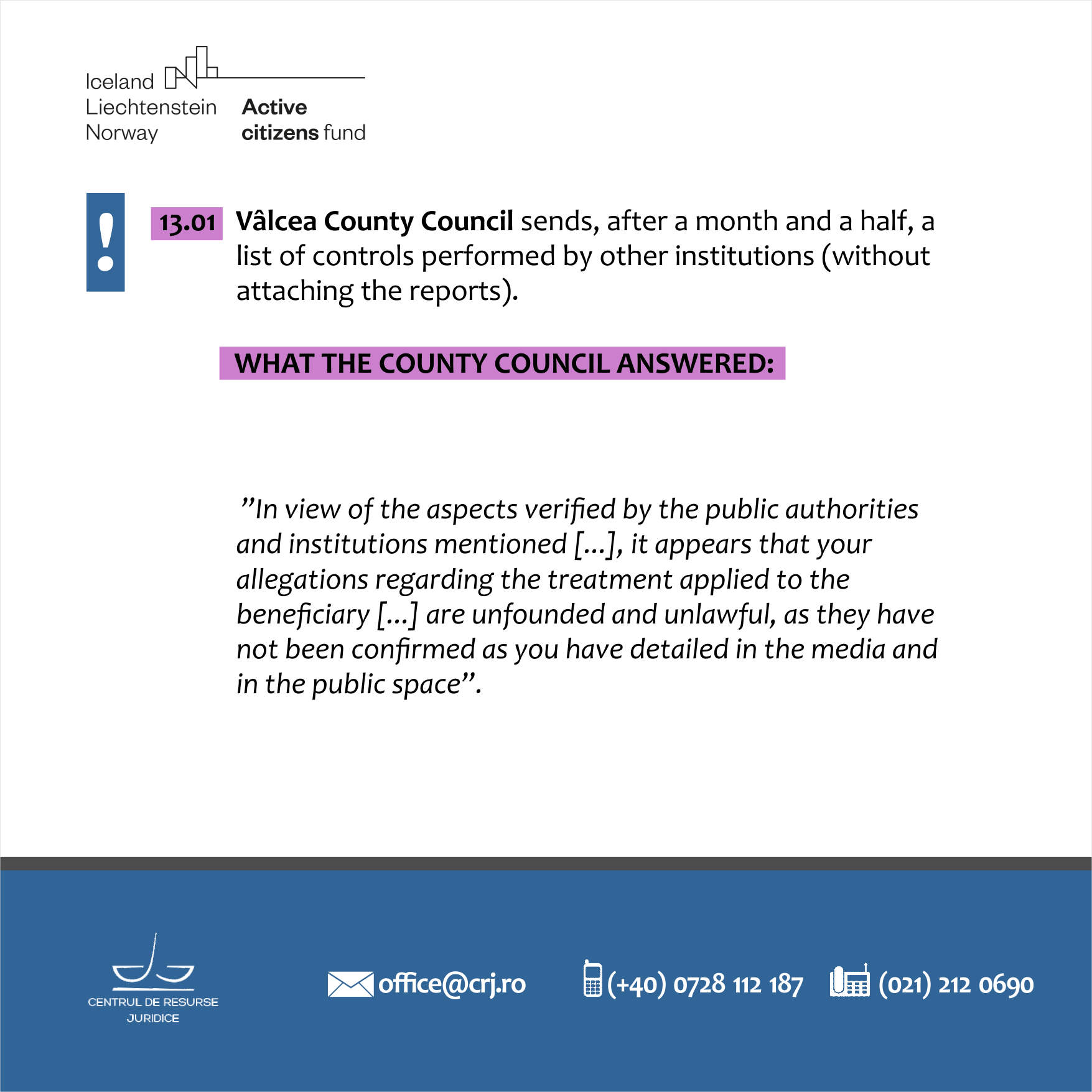
- The Vâlcea County Council replied on 13.01.2022 that the above-mentioned controls had been carried out, and there are, at this moment, 4 documents – information reports and control notes written in this case, documents that have not been provided to us to read their content. However, the answer ends with the following statement: ‘In view of the aspects verified by the public authorities and institutions mentioned (our note – so not by the Prefect’s Institution of Valcea) […], it appears that your allegations regarding the treatment applied to the beneficiary […] are unfounded and unlawful, as they have not been confirmed as you have detailed in the media and in the public space”.
We still wonder why there is a case pending before the Public Prosecutor’s Office, if all the information referred to has proved to be unfounded.
CJ Vâlcea’s answer available HERE.
__________________________________________________________
- The Prefect’s Institution of Valcea responds, on 10.12.2021, through an address informing CLR that the request has been forwarded to other institutions. The reply HERE.
__________________________________________________________
Conclusions following responses received by 13 January 2022:
We have 6 answers from 5 state institutions with attributions of monitoring, verifying and controlling how the rights of people with disabilities are respected. In addition, there is a report from the Monitoring Council, available aici.
These answers and reports do not essentially bring anything new. They are either incomplete answers or make general recommendations (or none at all).
We have also noticed that reports or responses from institutions under the same ministry contain diametrically opposed conclusions or comments on certain issues. We wonder how such a situation is possible, given that each institution bases its analysis on the same evidence or facts.
The activity is part of the project “FREE TO DECIDE. Transition from Guardianship to Supported Decision-Making for People with Disabilities”, with the financial support of Active Citizens Fund Romania, a programme funded by Iceland, Liechtenstein and Norway through EEA Grants 2014-2021. The content of this webpage does not necessarily represent the official position of the EEA and Norwegian Grants 2014-2021; for more information please visit www.eeagrants.org. Information about Active Citizens Fund Romania is available at www.activecitizensfund.ro.
Working together for an inclusive Europe!

